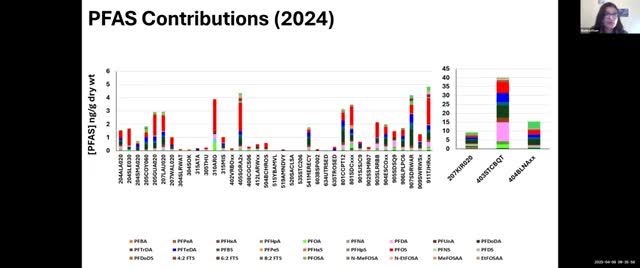Region 4 reports increasing PFAS concentrations at Bouquet Canyon site in 2024 analysis
April 26, 2025 | California Water Quality Monitoring Council, Boards and Commissions, Executive, California
This article was created by AI summarizing key points discussed. AI makes mistakes, so for full details and context, please refer to the video of the full meeting. Please report any errors so we can fix them. Report an error »

California's Water Quality Monitoring Council has reported significant findings regarding the presence of PFAS compounds in urban sediments during its recent 2025 SPoT SRC Meeting. The analysis revealed that 35 sites were monitored for a suite of 40 PFAS compounds, including legacy substances like PFOS and PFOA, as well as newer alternatives marketed as safer options. Notably, three sites consistently showed the highest levels of PFAS detections from 2023 to 2024, indicating a complex mixture of these contaminants.
Among these sites, Bouquet Canyon in Region 4 exhibited a marked increase in PFAS concentrations in 2024 compared to the previous year. This trend underscores the importance of ongoing monitoring, as the presence of PFAS compounds can complicate the toxic profiles of these locations, even if the levels of PFAS themselves do not reach toxic thresholds.
In addition to PFAS, the meeting addressed other contaminants, including PAHs, PVDEs, and organophosphates. The data indicated that while some PAHs showed an increase at a small number of sites, overall trends remained stable across most urban locations. The Council has decided to retire PAHs, PVDEs, and organophosphates from its regular monitoring cycle, suggesting a shift in focus towards more pressing contaminants.
The analysis of metals, particularly copper, cadmium, and lead, revealed decreasing trends at 90 monitoring spots, which may reflect the impact of recent regulatory measures, such as the copper brake pad law. The Council plans to concentrate future efforts on tracking these metals, especially in urban and agricultural contexts.
As the meeting concluded, participants were encouraged to discuss any specific regional or statewide data needs that could arise from these findings. The ongoing monitoring and analysis of these contaminants are crucial for ensuring water quality and public health in California.
Among these sites, Bouquet Canyon in Region 4 exhibited a marked increase in PFAS concentrations in 2024 compared to the previous year. This trend underscores the importance of ongoing monitoring, as the presence of PFAS compounds can complicate the toxic profiles of these locations, even if the levels of PFAS themselves do not reach toxic thresholds.
In addition to PFAS, the meeting addressed other contaminants, including PAHs, PVDEs, and organophosphates. The data indicated that while some PAHs showed an increase at a small number of sites, overall trends remained stable across most urban locations. The Council has decided to retire PAHs, PVDEs, and organophosphates from its regular monitoring cycle, suggesting a shift in focus towards more pressing contaminants.
The analysis of metals, particularly copper, cadmium, and lead, revealed decreasing trends at 90 monitoring spots, which may reflect the impact of recent regulatory measures, such as the copper brake pad law. The Council plans to concentrate future efforts on tracking these metals, especially in urban and agricultural contexts.
As the meeting concluded, participants were encouraged to discuss any specific regional or statewide data needs that could arise from these findings. The ongoing monitoring and analysis of these contaminants are crucial for ensuring water quality and public health in California.
View full meeting
This article is based on a recent meeting—watch the full video and explore the complete transcript for deeper insights into the discussion.
View full meeting
